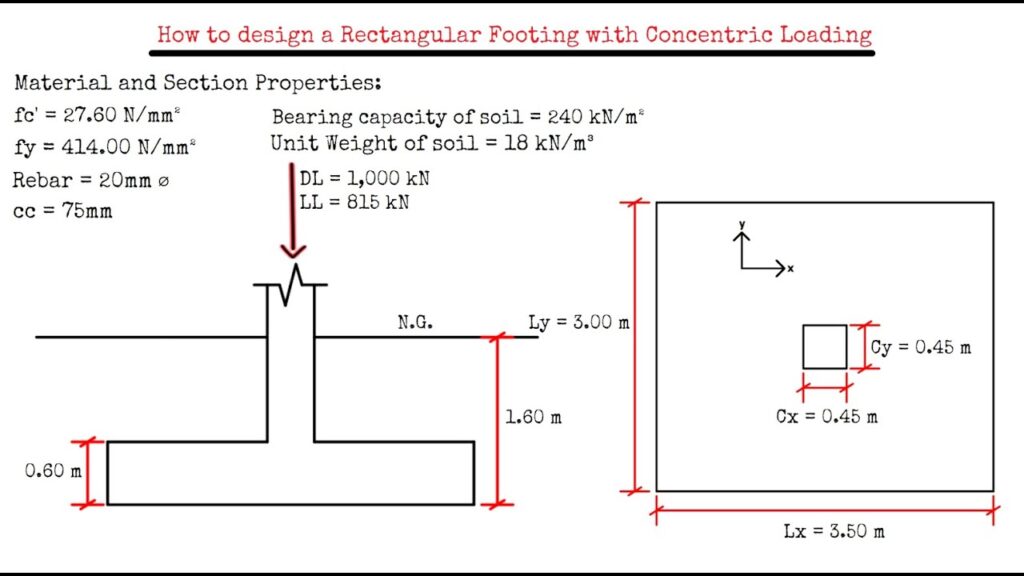Footing Design Calculator: These tools can significantly speed up the design process and reduce the potential for errors.

Here’s a breakdown of what to look for in a footing design calculator and some considerations when using them:
What Makes a Good Footing Design Calculator?
- Code Compliance: The most crucial aspect. The calculator must be based on a recognized and specified building code (e.g., ACI 318, Eurocode 2, IS 456). Ensure the calculator version aligns with the current version of the code you’re using.
- Clear Input Parameters: The calculator should clearly label all input parameters and provide guidance on their units and meaning. Examples include:
- Column loads (axial, moments)
- Soil bearing capacity (allowable)
- Concrete compressive strength (f’c)
- Steel yield strength (fy)
- Concrete cover
- Load factors (if not built-in)
- Output of Key Results: The calculator should provide the key design results clearly and concisely, including:
- Footing dimensions (length, width, depth)
- Required reinforcement area (As)
- Reinforcement spacing and bar size
- Shear checks (one-way and two-way)
- Bearing stress check
- Development length check
- Utilization ratios (e.g., bending moment capacity / applied bending moment)
- Assumptions and Limitations: A good calculator will explicitly state its assumptions and limitations. This is important for understanding the scope of its applicability and avoiding misuse. For instance, it might assume a perfectly rigid footing or neglect certain load types.
- Verification Examples: Ideally, the calculator should provide verification examples that demonstrate its accuracy by comparing its results to hand calculations or established design examples.
- User-Friendliness: The calculator should be easy to use and navigate. A clear and intuitive interface can significantly reduce the risk of errors.
- Ability to Handle Different Footing Types: Some calculators can handle isolated, combined, and even strap footings.
- Reporting Capabilities: The ability to generate a report summarizing the input parameters and design results is highly valuable for documentation and review.
- Units Consistency: The calculator should consistently use a specified set of units (e.g., SI or US Customary).
Where to Find Footing Design Calculators:
- Software Vendors: Companies like Bentley (STAAD.Pro), RISA (RISAFoundation), and CSI (SAFE, ETABS) often have integrated footing design modules within their structural analysis and design software. These are generally the most robust and reliable options, as they are developed and maintained by professional software developers.
- Online Calculators (with Caution): There are many free online footing design calculators available. However, use these with extreme caution! It’s essential to thoroughly verify their accuracy and code compliance before relying on their results. Look for calculators from reputable engineering organizations or universities. Pay close attention to their stated assumptions and limitations.
- Spreadsheets (Build Your Own): Creating your own footing design spreadsheet can be a valuable learning experience. It allows you to fully understand the underlying calculations and tailor the calculator to your specific needs. However, be prepared to invest significant time and effort in developing and verifying the spreadsheet.
- Professional Engineering Associations: Some professional engineering associations (like ASCE) may offer design aids or calculators for their members.
Important Considerations When Using Any Footing Design Calculator:
- Verification is Key: Never blindly trust the results of any calculator! Always verify the results by performing hand calculations or comparing them to established design examples. Focus on the critical checks like shear, bending moment, and bearing stress.
- Understand the Assumptions: Be fully aware of the calculator’s assumptions and limitations. Don’t use it for situations that fall outside of its intended scope.
- Proper Input is Crucial: Garbage in, garbage out. Ensure that you’re providing accurate and consistent input parameters.
- Code Updates: Building codes are constantly evolving. Make sure the calculator you’re using is up-to-date with the latest code revisions.
- Professional Judgment: A calculator is a tool to assist you, not a replacement for your engineering judgment. Always review the results critically and consider whether they make sense from a practical engineering perspective.
- Document Everything: Keep a record of the calculator you used, its version, the input parameters, and the design results.
Example Calculator Features (Illustrative):
Imagine a calculator based on ACI 318:
- Footing Type: Isolated Square/Rectangular
- Input:
- Factored Axial Load (Pu): kN/kips
- Factored Moment X (Mx): kN-m/kip-ft
- Factored Moment Y (My): kN-m/kip-ft
- Column Width X (cx): mm/in
- Column Width Y (cy): mm/in
- Allowable Soil Bearing Pressure (qa): kPa/psf
- Concrete Strength (f’c): MPa/psi
- Steel Yield Strength (fy): MPa/psi
- Concrete Cover: mm/in
- Output:
- Footing Length (L): m/ft
- Footing Width (B): m/ft
- Footing Depth (h): mm/in
- Required Area of Steel (Asx): mm²/in² (X direction)
- Required Area of Steel (Asy): mm²/in² (Y direction)
- Bar Size: (e.g., #4, #10, 12mm)
- Bar Spacing: mm/in
- One-Way Shear Check: Pass/Fail, Shear stress and allowable stress values
- Two-Way Shear Check: Pass/Fail, Shear stress and allowable stress values
- Bearing Pressure Check: Pass/Fail, Bearing pressure and allowable pressure values
In Summary:
Footing design calculators can be powerful tools for structural engineers, but they must be used responsibly and with a healthy dose of skepticism. Always prioritize code compliance, verification, and professional judgment. Choose calculators carefully, understand their limitations, and never rely on them blindly.

